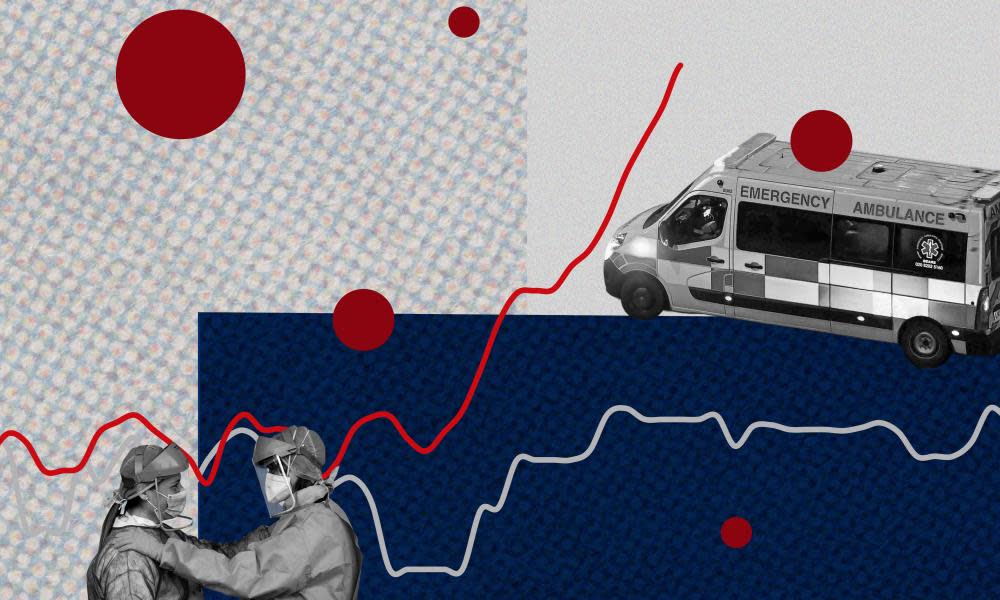NHS crisis in charts: how Covid has increased strain on health service

The NHS is in the grips of a winter crisis like no other. Friday was the ninth day in a row in which the number of people being treated in hospital for Covid hit a new high, with 32,975 patients now on wards across England.
Seventeen NHS trusts are treating more coronavirus patients than non-Covid patients and six have more than 50% of beds taken up by Covid patients. One in five English trusts treated at least twice as many patients on at least one day last week as in their first-wave peak.
All this comes as the health service enters its busiest time of the year as seasonal flu and weather-related accidents peak. These charts outline the scale of the challenge facing the NHS England this winter.
Covid hospitalisations at record high
On the current trajectory, the number of people being treated for Covid in England’s hospitals could soon be double the April 2020 peak of 18,974. On Thursday the figure stood at 32,925, 74% higher.
default
Every NHS region in England treated more patients in the week to 14 January than in their first-wave peak, with all seven recording their highest figures on Wednesday or Thursday.
Even though hospitals are better equipped to deal with coronavirus in this second wave, demand is putting huge strain on the NHS. Two and a half times as many Covid patients as in the first-wave peak were treated in the south-east and east of England on the worst day last week.
There had been some tentative signs this week that admissions may have peaked in London and the south-east, but the subsequent days’ data was less encouraging and admissions in England as a whole continue to increase, albeit at slower pace.
Toughest winter on record
While the NHS does usually see increased demand at Christmas, the scale of demand this year is unprecedented. There are 4,529 adult critical care beds occupied in England – more than 1,000 more than at any point in the past five winters.
This is because coronavirus is far more deadly than flu, which is the driver of a lot of NHS demand in a normal winter. Prof Chris Whitty, England’s chief medical officer, has previously said seasonal flu kills about 7,000 people annually in the UK, or up to 20,000 in a bad year. The UK has recorded more than 80,000 deaths within 28 days of a positive Covid test, and more than 100,000 when all deaths with Covid listed on death certificates are taken into account.
Six trusts are coronavirus-majority services
Covid patients are taking up more than half of all bed capacity in six English acute trusts, and half in two more. For example, in the week to 12 January, 63% of beds at Whittington Health NHS trust in north London were occupied by Covid patients – an average of 145 beds, compared with 79 for non-Covid patients and seven unoccupied.
A further 34 trusts had a third or more of their beds taken up by Covid patients on average in the past week. These numbers have been improved by the fact that trusts across the country have increased their numbers of beds.
A&E data shows people avoiding hospital – albeit not as many as in first wave
A combination of increased demand and public reluctance to go to hospital due to the pandemic had a huge impact on the delivery of health services during the first wave. Figures released on Thursday indicate that the fall-off in services has not yet reached the first-wave peak, but it is a mixed picture.
More people than ever were waiting for a referral for treatment, at 4.46 million – a figure that has risen every month since June. There are 192,169 who have been waiting a year or more for treatment, the highest on record. On a more positive note, median waiting times have been declining in recent months and stand at 10.4 weeks, down from 19.6 weeks in July.
A&E attendances fell back again in November and December to the fourth lowest level on record, coinciding with a rise in Covid case numbers and local lockdowns. Attendances were still 61% higher than at the low point last April.
Cancer treatments, which were severely affected in the first wave, have now recovered, with most metrics reaching or approaching pre-Covid levels. As an example, 205,182 people got their first cancer consultation within two weeks of an urgent referral from their GP in November, in stark contrast to April and May at 79,573 and 106,535 respectively.
However, Macmillan Cancer Support struck a note of caution. “We must remember that this data reflects the state of our cancer services two months ago, before the current surge in coronavirus cases, which we know has caused further disruption,” said its head of policy, Sara Bainbridge, adding that tens of thousands of people had missed a cancer diagnosis since the start of the pandemic.
Prof Stephen Powis, the NHS national medical director, said: “The NHS has cared for nearly a quarter of a million Covid-positive patients already, who collectively spent more than 2m nights in hospital, while also keeping emergency care running.
“These figures are a stark reminder that the NHS is facing an exceptionally tough challenge, and that while still millions of people are getting care for non-Covid health problems in the NHS in England – indeed, for every Covid patient in hospital, the NHS is treating three people for other conditions – there is no doubt that services will continue to be under additional pressure until and unless this virus is under control, which is why it’s so important that everyone practises social distancing and follows national guidance.”

 Yahoo News
Yahoo News 
